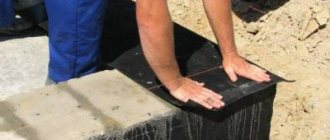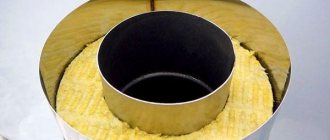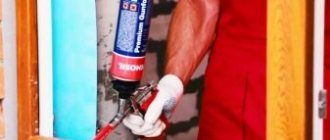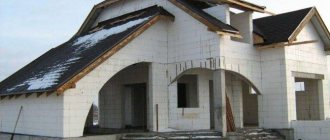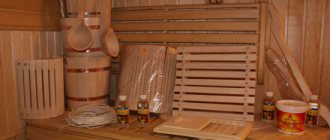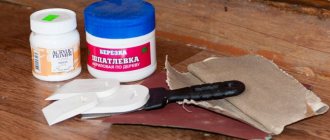[contents]
Below we will consider in more detail the technical and operational properties of bitumen, as well as what technology must be followed when applying this material to the surface.
What is bitumen mastic?
Understanding what bitumen mastic is is not very difficult. In simple terms, this is bitumen improved with the help of various additives. Due to these additives, the bitumen composition is resistant to cracks and is also thicker. Therefore, if the question arises of how to insulate the roof of a private house, do not forget to take into account the layer of bitumen mastic. If we talk about the appearance of this composition, it resembles a paste, deep black in color.
Despite the fact that this product appeared on the Russian market relatively recently, it quickly gained popularity. It is safe to say that at the moment bitumen mastic is one of the best-selling products in the field of building materials and roofing materials.
Consumption and consumption rate
Consumption per 1 sq.m. varies depending on the type of mastic used; hot types do not shrink after drying. The average is 2-2.4 kg/sq.m., with a layer of 2 millimeters. The dry residue has a direct impact on consumption; the lower the indicator, the more product will be required, usually this indicator varies from 20 to 70%.
The average is 2-2.4 kg/sq.m., with a layer of 2 millimeters.
How to dilute bitumen mastic to a liquid state?
And now some useful tips for craftsmen on how to dilute bitumen mastic to a liquid state. As is known, according to its composition, bitumen mastic is divided into several types. Also, the material is also divided according to the method of application and technical characteristics.
Some types of mastic cannot be used in certain conditions, for example at very low temperatures. Also, if the mastic needs to be heated, then the temperature of the composition must be at least 160 degrees. Only after this can the products be used for work. If we talk about cold mixtures that can be used when installing PVC membrane roofing, the conditions of use will be different. The most important thing is not to heat it, use it in its original form.
Also, if you use cold mastic, it needs to be diluted. Concentrated material may thicken too much and play a cruel joke on you. But, the components for dilution depend on how the composition will be applied to a particular surface.
If you prefer to dilute any compositions with a solvent, then in the case of mastic we do not recommend doing this. Since the solvent tends to evaporate, therefore, when the mastic hardens, this is more likely to happen. By the way, when installing a membrane roof, the price of work per m2 is calculated together with the preparation of the consumables themselves.
Therefore, if you hire specialists to lay mastic, you don’t have to worry about what and how to dilute it. All this is done by masters. The best thinners are components such as:
- Kerosene;
- Petrol;
- Diesel fuel (diesel fuel).
All these substances have the property of “holding” their shape. That is, if the proportions are observed correctly, they will not curl up, evaporate, or change their technical qualities. In addition, they are easy to obtain on the market.
Popular manufacturing companies in our market
Well-known brands include TechnoNIKOL, Descartes and KhimTorgProekt. All of them have been on the market for more than 20 years and the reviews are good. I’ll briefly tell you about their rubber and bitumen mastics.
TechnoNIKOL
It produces two special brands: AquaMast (AkvaMast) and TechnoNIKOL No. 20. Both products are completely ready for use, but can be diluted with organic solvents.
Designed for arranging mastic waterproofing of various building structures, as well as repairing any types of roofing, creating protective anti-corrosion layers, etc.
Packaging: metal buckets with a capacity from 3 to 20 liters.
Descartes
It produces cold-curing rubber-bitumen mastic called Expert. It is used for repair and installation of roofing, external waterproofing of various building communications, anti-corrosion protection of metal surfaces and gluing a number of rolled materials.
Packaging: 1.8 kg jar or 18 kg bucket.
How to apply bitumen mastic?
There are a lot of options for applying bitumen mastic. It all depends on its consistency, concentration and conditions of use. It is clear that it will usually be very difficult to apply cold mastic with a painting brush. Due to the fact that the composition is cold, the brush will get stuck, hairs will stick and be torn out. As a result, the tool may completely freeze in a jar of mastic.
Also, the surface on which the composition is applied plays an important role. If you are fundamentally unfamiliar with the technology of installing membrane roofing, then we do not recommend working with it without preparation. You risk damaging the tool, the solution itself, and most importantly, damaging yourself. Especially if it gets very hot.
Let's return to surfaces. Firstly, based on its area, the type of work is determined. If the area is small, it is possible to apply mastic to the required places with human effort. If this is a full-fledged roof of a house or a facade, then it is better to use a mechanized method.
For the manual method, a short-haired roller or a fluted brush is suitable. It differs from a regular brush in that it is more resistant to the viscosity of bitumen. Thus, it better distributes the product over the surface without allowing streaks and unevenness. If mastic is applied mechanically, this is done with a special mechanical sprayer. Under its pressure, the product is distributed evenly and symmetrically.
Comparative table of properties of bitumen and mastics for various applications
| Cold solvent-based mastic | Cold water-based mastic | Hot mastic | Bitumen | |||
| Options | Roof | Foundation | Roof | Foundation | Roof | Foundation |
| Thickness of 1 layer, mm | 1,0 | 0,5-1,0 | 1,0 | 0,5-1,0 | 2,0 | 1,0 |
| Consumption per 1 layer, kg/m2 | 1,0-2,0 | 1,0-1,5 | 1,5 | 1,0-1,5 | 2,0-2,5 | 1,0 |
| How long does it take to dry at 20 °C and 50% humidity, hours | 24 | 24 | 5 | 5 | 4 | 24 |
| Temperature at which work can be performed, °C | -10 to +40 | -10 to +40 | From +5 to +40 | From +5 to +40 | From +5 to +40 | From +5 to +40 |
| Base humidity no more than, % | 4 | 4 | 8 | 8 | 4 | 4 |
What is the difference between primer and bitumen mastic?
To understand the difference between primer and mastic, it is enough to know the definitions of both terms. By the way, this will help you reduce the cost of installing a PVC membrane on the roof, since you will know the basic qualities of the material. So, we have already figured out what bitumen mastic means.
In turn, bitumen primer is, in principle, a product similar in composition. Only it is produced on the basis of bitumen, and contains various solvents of organic origin. Also, the components of the bitumen primer are minerals and polyminerals.
The primer should only be applied to a previously cleaned and degreased surface. Due to its more liquid and watery structure, the primer is able to penetrate deeper, thereby filling all voids and internal cracks/chips. This is very important when treating membrane soft roofing with similar materials.
Quality issues: why sometimes mastics don’t harden
You've probably heard about the problems roofers face: sometimes mastics don't dry at all, are difficult to apply, emit an unbearable odor and drip.
The thing is that in our country all bitumen mastics are conventionally divided into three price segments. In fact, all the characteristics of bitumen mastic directly depend on what pricing policy it is in and who its manufacturer is.
The premium segment, which includes products from domestic and foreign manufacturers, is high-quality mastics, durable and frost-resistant. Some of them are even modified with SBS rubber. They dry quickly and hold up well because they are made on the basis of bitumen of a grade not lower than BN 70/30.
By the way, so that you understand a little about the quality of the purchased mastic, we will tell you the decoding of this value: 70 means heat resistance (softening temperature), and 30 is the temperature at which a needle can penetrate the mastic (mechanical resistance). And finally, premium mastics contain relatively non-toxic petroleum solvents.
Bitumen mastics in the mid-price segment are currently produced by seven Russian manufacturers. Frankly speaking, these are average quality mastics based on bitumen, starting with the BN 50/50 brand, occasionally with rubber additives. They use cheap petroleum solvents, and therefore the surface treated with them will dry for 24-72 hours per layer. And it is these mastics that give off an unpleasant, pungent odor.
But the cheapest mastics have received a completely negative reputation, which, as they say, cast a shadow on the entire segment of bitumen waterproofing. They do not meet any GOST requirements at all, and are similar to ordinary mastics only in color.
It is these mastics that hardly dry and are completely useless as a repair material. However, they also have their own scope of application. Such mastics are made from just one fraction of oil, called tar, and a little real construction bitumen is added as an additive.
As a result, such mastic, even after curing, flows off the surface at an angle of 30°, dries for more than a week and still remains sticky, and each season requires its own renewal. Cheap mastics do not stick to surfaces at all, are toxic and emit a terrible odor.
And the sad thing is that if you decide to re-treat everything with another mastic, this one will have to be scraped off by hand to scratch. Why can't you leave it? The fact is that bad mastics have the same poor adhesion, and pouring a new coating will not fill the cavities under the old one.
This is what this mastic looks like a year after application:
Roofing bitumen mastic is subject to increased requirements for frost resistance and weather resistance. That is why this category is specially further modified with an elastomer such as SBS - styrene butadiene rubber.
This allows the mastic not to crack over time, especially during periods of frost. Do manufacturers of cheap mastics take all these features into account? Hardly.
How to wash bitumen mastic?
If you are faced with a situation where you need to wash bitumen mastic, the first thing it could be is a solvent. But let us immediately note that this works if the composition is still hot or warm. When the mastic has already hardened, especially concentrated, and some time has passed, then simply erasing it chemically will be very difficult and energy-consuming.
You need to understand that the mastic contains petroleum products. This gives it additional resistance to laundering. Therefore, when choosing a product, it is necessary to consider what type of surface it will need to be cleaned from. In addition, the volume of excess plays a big role in the choice of cleaning method and product.
As we have already said, bitumen contains an impressive percentage of petroleum products. This allows the mastic to be used in almost all types of construction work, including when laying and installing PVC roofing on the roof.
Mastic is, to put it mildly, a sticky material. Once cooled, it literally solders to the surface. Therefore, if even a small amount of bitumen gets on clothes or other things, you can’t just wipe it off. Mastic can only be removed by heating it to at least 50 degrees.
The biggest mistake most people make is to immediately aggressively tear off the mastic and try to scrape it off. This will completely damage the material to the point that it cannot be restored. If the bitumen layer is too thick, then it makes sense to heat it and cut off a little thickness. But this is the maximum that will have to be done.
Unlimited material possibilities
Nowadays there are often situations when bitumen mastic is used to fix polystyrene foam to metal, concrete, expanded clay, and wooden surfaces. For horizontal slabs, a load is used, and for vertical slabs, special supports are used.
When lining fireplaces, you also cannot do without a bitumen-polymer strong, bactericidal, durable, heat-resistant adhesive material.
There are also mastics that are used specifically for road repairs. They work in tension and compression, tolerate temperature changes, and have good adhesion. Before you start using it, you don’t need to wait a long time – just an hour and you’re done.
Rubber-bitumen, bitumen-polymer mastics are used for metals and cars. But before application, as in all cases, the surface should be thoroughly cleaned, rinsed and dried.
No matter how durable a material such as concrete is considered, there is a problem of moisture seeping through micropores. Mastic also improves the characteristics of concrete structures by filling all cracks and cracks. The material can be prepared from solid or rubber bitumen, liquefied materials.
What is bitumen mastic used for?
It makes no sense to talk a lot about what bitumen mastic is needed for. Indeed, due to its properties, which are tightness and at the same time elasticity, the composition is actively used in construction for most repair work. Mastic has no less significant use in laying roofing materials.
And, of course, bitumen, as the primary material, is used in laying asphalt. Thus, hot asphalt chips are hermetically fixed to the road surface, supporting the weight of even particularly heavy cars and heavy trucks. Yes, the composition of road bitumen differs from the mastic used for waterproofing roofs, foundations, swimming pools or ponds. But the basis of the composition and its technical characteristics are similar.
Qualities of compositions
In addition to the fact that cold bitumen mastic reduces the time of waterproofing work and is easy to use, as stated above, it has a huge number of positive aspects:
- you can get a composition of any thickness, just add a solvent;
- durability - the modified composition can last more than 25 years without losing its insulating properties;
- versatility - any surface can be treated with bitumen mastic;
- ease of use - the composition can be applied independently using a trowel, roller or brush.
Like any material, waterproofing mastic has disadvantages:
- price – if we consider bitumen-polymer mastics for waterproofing, then their cost is significantly higher;
- Unlike hot-applied bitumen-based mastic, this material shrinks more strongly, which consequently increases insulation consumption.
The consumption of mastic per 1 m2 of waterproofing depends on the method of application, for example, when applying an adhesive layer, 1 kg of composition per square is sufficient. If you create full insulation with mastic, it will take up to 5 kg. Knowing these parameters, it is very easy to calculate how much material will be needed.
Bitumen mastic or primer: which is better?
If you are choosing between bitumen mastic and primer and don’t know which is better, be sure to read this part of the article. By the way, if you decide to install a soft roof with your own hands according to the instructions, this issue will definitely be on the agenda. It would seem that they are two similar products, but which is better?
Let us say right away that for each case a different composition is selected. It all depends, as a rule, on the surface on which the primer or mastic will be applied, the conditions of application and the type of work. In general, the most important difference between one product and another lies in the scope of their application.
Bitumen mastic is used for waterproofing work on roofs, facades, foundations or water tanks, etc. The primer, in turn, is used for road work, including when laying crushed stone and asphalt chips, and carrying out communications, namely gas or water.
Of course, when eliminating corrosion and other mechanical damage to the pipeline, the primer has no place. If the list of repair work includes priming the surface, the primer will become an indispensable component for this activity. Having found out what dismantling of structures is, you will learn what role both mastic and primer play in this work. And also whether they are needed there in principle or not.
Main application in construction
- Waterproofing of various building communications (concrete foundation elements and wooden beams);
- Anti-corrosion protection of iron surfaces (pipelines and steel tanks for various purposes);
- Sealing filling of seams, cracks, chips, etc.;
- Bonding of a number of waterproofing materials;
- Can be used for soils of weak and medium aggressiveness.
When cold, the mastic is supplied in closed containers. It is ready for use, provided the ambient temperature is from -20° to +40°. However, if the application temperature is below +5°, it is required to keep it in a warm room for at least 24 hours. Before work, you should mix thoroughly, and to obtain a more liquid substance, dilution with organic solvents (solvent, white spirit, etc.) is allowed.
Foundation waterproofing
Roofing
Waterproofing walls
Bitumen mastic does not dry: what to do?
If bitumen mastic does not dry, this can become a serious obstacle to work. So what to do and how to deal with it, so to speak. When an estimate is drawn up for repairing the soft roof of an apartment building, this point is not taken into account by contractors. However, even an experienced worker can face this difficulty.
Such cases arise, as a rule, due to the lack of time available for the bitumen to dry. Many workers, due to inexperience or other reasons, assume that the drying process itself does not take much time. But, fortunately, there are quite simple, but at the same time, productive methods to speed up the drying process of the composition.
The most common method is used at the stage of applying mastic to the surface. Instead of rollers/brushes and other means, it is better to apply the mastic with a spatula. Due to the formation of so-called grooves, the solvent contained in the composition will evaporate faster, which means the bitumen itself will dry faster.
After applying mastic to a certain area, it is very important to ensure that it is isolated from direct moisture, even in small quantities. Also, it is better to provide constant air access to the treated area in order to create circulation. You should not cover the areas with polyethylene or stretch film, as such manipulations will block the access of air, which will negatively affect the drying of the composition.
If the work is carried out in an open space, it would not be a bad idea to install devices for artificial drying, for example, heaters, heat guns, fans. As for the drying speed of mastic on roofs, it all depends on the type of soft roof for the garage and its area.
What is bitumen, pros and cons
Bitumen is an asphalt substance that is obtained after processing petroleum products; the product looks like a black resin. Bituminous mastics also appear as a black resin that looks like a paste. It stands out for its viscous and plastic properties, which helps to apply it to the surface with ease. To increase ease of use, as well as improve the characteristics of the coating, the product contains other polymer additives to create a layer that will not allow liquids to pass through, creating an invulnerable coating.
Also, to improve the properties of the material, thickeners are added; they help to create a high-quality insulating coating on the surface. Elements are also used that prevent cracking of the layer, substances to create a good degree of adhesion to different substrates. To obtain anti-corrosion characteristics, the composition contains special additives.
As a result, the use of data and other elements, which may vary slightly depending on the type of product, results in an even sealed layer. Through which water simply cannot penetrate to the base. Among the advantages of liquid mastic, the following are emphasized:
- Receiving a coating without seams, which eliminates leakage;
- Helps make the surface smooth and cover small flaws in the material;
- High level of connection with the base, which prevents detachment and swelling of the base;
- The surface of the layer does not crack;
- Can be applied to rusty areas on iron; can be used to cover an old roof;
- Durability, service life reaches 25-30 years;
- High tensile strength, increased mechanical stress will not lead to loss of integrity of the product;
- Ease of use;
- Does not exert heavy loads on the roof;
- You can use a thinner to prepare a product of any consistency.
High tensile strength, increased mechanical stress will not lead to loss of integrity of the product.
Many advantages do not exclude the presence of disadvantages of the solution. The following disadvantages can be identified:
- To work, you need to get a flat base, otherwise the viscous consistency will lead to differences in the mastic along the inclined zones. To correct this issue, you can add thickeners and a cement mixture. If there are significant holes or bumps, it is recommended to level them first so that the layer is reliable;
- Acceptable operating conditions do not include rain and negative temperatures, so the possibility of use is somewhat limited by weather conditions;
- It is difficult to regulate the thickness of the mastic distribution over the surface, which sometimes leads to excessive consumption of the composition.
These pros and cons of the mastic product determine its popularity; of course, there are disadvantages, but they are justified by the benefits obtained from using the product.
Acceptable working conditions do not include rain or negative temperatures.
Polymer-bitumen mastic: what is it used for?
And the last thing we have to deal with in this article is why and where polymer-bitumen mastic is used. In general, this material is primarily used for waterproofing and vapor barrier of facades and roofs. And also, the interfloor ceiling is treated to protect it from mechanical damage and the effects of climatic conditions.
Within our country this is most important. Since in some cities high humidity prevails in symbiosis with hot weather. While in more northern latitudes there are stable frosts and cold precipitation most of the year.
Thus, bitumen mastic is a high-quality and widely used material. Despite its relatively recent introduction to the Russian market, the composition of waterproofing bitumen has rapidly gained popularity and deservedly positive reviews from users.
Does mastic have any disadvantages?
There are not many disadvantages of bitumen mastics. And even the existing disadvantages are more of some limitations in application that are encountered in rare cases. So, among the disadvantages there are:
- The need to apply on a flat surface, otherwise the liquid substance may flow to one side. To reduce the fluidity of the substance, thickeners and cement are used. It is important to carefully prepare a surface with pits and tubercles and smooth out all defects.
- Cannot be used during rain. Water-based mastics also cannot be used at subzero temperatures.
- Difficulties in controlling the thickness of the applied layer, which may increase the consumption of bitumen mastic .
How to make mastic at home
Let's move on to the fun part - making homemade mastic. Everything is done quite simply, it is only important to completely follow the recipe. So, the top 3 mastic recipes that you can prepare at home.
Milk mastic recipe
And the first, most popular option is milk mastic.
Ingredients for 1 serving:
- 200 g Powdered milk
- 200 g of powdered sugar (prepare with extra)
- 150 g Condensed milk
- 1 tsp. Lemon juice
Mix the powdered sugar and sift. Add condensed milk and lemon juice. Knead the mastic mass. It should be elastic, homogeneous and not stick to your hands. Add more powdered sugar if necessary. After this, put the mastic in the refrigerator for a while.
For coloring, use gel water-soluble dyes.
The shelf life of mastic depends on the volume and correctness of its packaging and maintaining optimal conditions. Shape the mastic into ovals or balls and store in the freezer or refrigerator. The shelf life of this mastic is up to 4 months.
Marshmallow mastic recipe
The second type of mastic, no less popular, is mastic made from marshmallows.
It’s quite easy to make mastic for a cake at home from marshmallows (or similar substitutes like “Bon Pari”, “Sweet Snow”, etc.).
We will need:
- 100 g Powdered sugar
- 2 tbsp. l. Lemon juice
- 100 g Marshmallow
Place the marshmallows in a large container, sprinkle with lemon juice and heat in the microwave until they expand in volume (about a minute). The heated marshmallows must be thoroughly kneaded and kneaded with a spatula. The mass will resemble chewing gum. Gradually add powder and knead the mastic like dough. Let it sit for a couple of hours. If necessary, add a little more powder to the cooled mastic.
This mastic turns out to be quite dense and is excellent for sculpting figures. Its color depends on the color of the marshmallows and can be either perfectly white or colored.
Sugar mastic recipe
And the next recipe is gelatin mastic. Another popular option.
Ingredients for making gelatin mastic:
- 1 tsp. Gelatin
- 40-50 g Cold water for soaking gelatin
- ½ tsp. Lemon juice
- Powdered sugar
Soak gelatin in water to swell. The required time is indicated on the packaging. Then heat the gelatin until dissolved. Don't boil! Add lemon juice and dye to the warm solution. Knead the mastic dough, gradually adding powdered sugar. It takes about 100 grams, however, you need to be guided by the mixture: it should not stick to your hands, be soft and flexible and stretch well. Wrap the mastic in film and let it stand for a couple of hours.
I have shared with you the basic recipes for cake mastic. Once you try them, you are sure to find the one you like the most. decorate your cakes, and let nothing limit your imagination!
General technology and rules of application
The very first step in creating roof waterproofing is thorough cleaning of the base. The old coating is removed from it, all debris is removed and dust is removed. Next, apply a bitumen primer to a clean, dry base. To do this you will need a regular paint brush.
Very important: do not skip the step of cleaning the base under any circumstances, since without preparation it can be very difficult to create a layer of approximately the same thickness.
To apply cold mastic, use spatulas, rollers or brushes. This method is quite expensive, since it is more difficult to control the thickness of the layer.
Manual application of bitumen mastic
With the mechanized method, a special airless sprayer is used, which supplies the composition under a pressure of 150 bar.
Mechanized method of applying mastic
Important: the sprayer must have the function of mixing components inside the unit.
How to apply mastic correctly:
- Before starting, if necessary, warm the composition at room temperature, leaving it indoors for one day.
- Using the instructions, add solvent to the mastic and mix everything thoroughly.
- After cleaning the base and treating with primer, dry the roof.
- Pour a small amount of the mixture onto the roof and spread the mixture using a mop or scraper.
Please note: to increase the strength of the resulting waterproofing, you can lay a reinforcing mesh on the roof surface, and only then apply mastic.
To repair a metal roof, you need to clean it from oil stains, rust and organic contaminants, and then apply mastic in 2 layers, preferably with a coarse wide brush. It is also necessary to coat all passage elements and their joints with the roof with the composition.
Treating the junctions of elements with the roof with mastic
If local repairs to the roofing are necessary, then simply cut the swollen area crosswise, then bend the edges and apply a sufficient amount of mastic under them. Next, all that remains is to press the edges back. If necessary, you can additionally place a reinforcing mesh on the damaged area.
Local repair of roofing covering with mastic
Useful tips for effective use of mastic:
- When processing vertical planes, several layers are made.
- In order for the composition to adhere well, it is worth applying it from bottom to top in parallel stripes to the very top of the structure.
- For better mixing, you can use a drill with a special mixer attachment.


